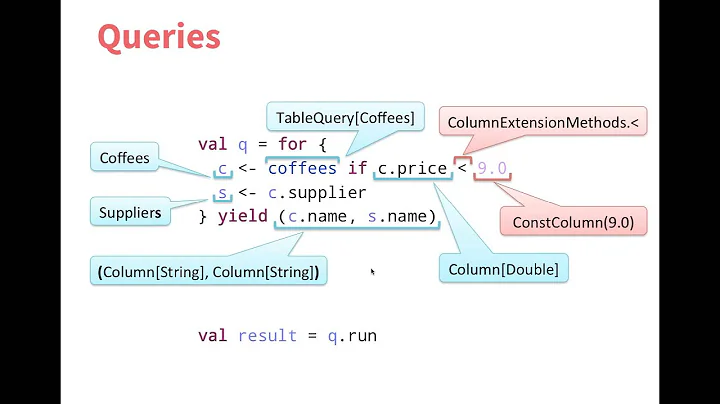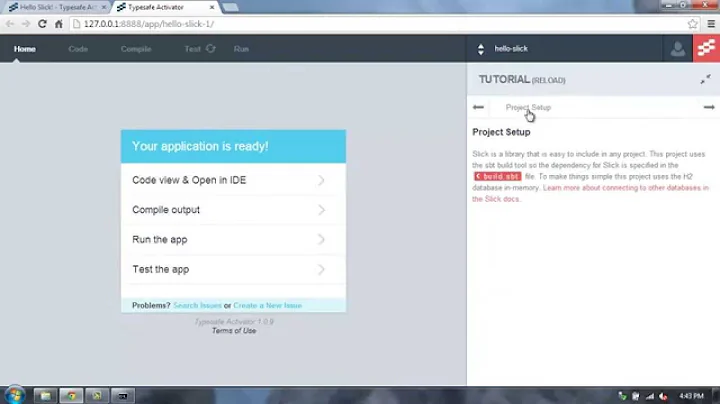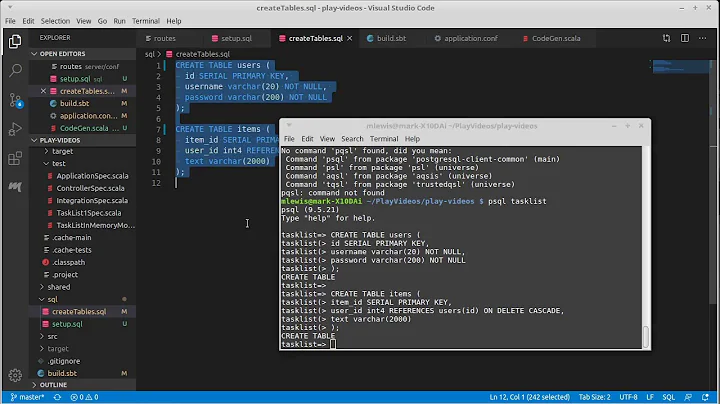Getting autoincrement values with Slick library in Scala
Solution 1
You can retrieve the generated value like this.
Add autoInc method to Users object.
def autoInc = id.? ~ first ~ last <> (User, User.unapply _) returning id
Use Users.autoInc.insert instead.
print(Users.autoInc.insert(User(None, "Jack", "Green" )))
See also:
https://github.com/slick/slick/issues/10
https://github.com/slick/slick/commit/09a65a8e88a0363412e218dc5c06023b69809649
Solution 2
The latest version of Slick (2.1.0) automatically takes care of ignoring the auto-incremented ids and the documentation demonstrates how to retrieve the id:
val userWithId =
(users returning users.map(_.id)
into ((user,id) => user.copy(id=Some(id)))
) += User(None, "Stefan", "Zeiger")
This is the full monty, where the retrieved value is then inserted back into the object you are adding to the table. If you just want to get your hands on the id itself:
val userId =
(users returning users.map(_.id)) += User(None, "Stefan", "Zeiger")
Both code snippets were taken from the official docs. It seemed like this question needed updating for newcomers (like me) who have never used earlier versions of Slick.
Related videos on Youtube
Comments
-
 Jack almost 2 years
Jack almost 2 yearsHow do I get the auto-incremented values for records inserted with Slick? The following code prints 1111. I would have expected it to print 1234
import scala.slick.driver.H2Driver.simple._ object TestMappedTable extends App{ case class User(id: Option[Int], first: String, last: String) object Users extends Table[User]("users") { def id = column[Int]("id", O.PrimaryKey, O.AutoInc) def first = column[String]("first") def last = column[String]("last") def * = id.? ~ first ~ last <> (User, User.unapply _) } implicit val session = Database.forURL("jdbc:h2:mem:test1", driver = "org.h2.Driver").createSession() session.withTransaction{ Users.ddl.create print(Users.insert(User(None, "Jack", "Green" ))) print(Users.insert(User(None, "Joe", "Blue" ))) print(Users.insert(User(None, "John", "Purple" ))) print(Users.insert(User(None, "Jim", "Yellow" ))) } }I'm using Slick 0.11.2 for Scala 2.10.0-RC1
-
 Jack over 11 yearsI kinda assumed it was, but turns out I was wrong. Thanks for the help.
Jack over 11 yearsI kinda assumed it was, but turns out I was wrong. Thanks for the help. -
Yaroslav over 10 yearsData manipulation queries usually return the number of rows affected.
-
-
 Jack over 11 yearsThis worked great for the H2 database, but PostgreSQL does not like it. Since this is not quite the same problem, I asked it as a new question: stackoverflow.com/q/13199198/828757
Jack over 11 yearsThis worked great for the H2 database, but PostgreSQL does not like it. Since this is not quite the same problem, I asked it as a new question: stackoverflow.com/q/13199198/828757 -
 AlexBrand almost 11 yearsWhat can be done when tables are larger? maybe 15-20 columns... the
AlexBrand almost 11 yearsWhat can be done when tables are larger? maybe 15-20 columns... theforInsertmethod becomes a monster! -
panther almost 9 yearsThis is more up to date answer. I am not sure if you can 'edit' the currently selected answer to add this as an update or at least link to this.
-
panther almost 9 yearsThis is now supported by Slick. See Brenden's answer below. Same is also possible in Slick 3.0.
-
User almost 9 yearsBut why is userId of type
FixedSqlAction[Int, NoStream, Effect.Write]? (tested in Slick 3.0.0) How to get the Int / Long? -
Chris Beach about 8 yearscould that last line be
user.copy(id = Some(id))?









